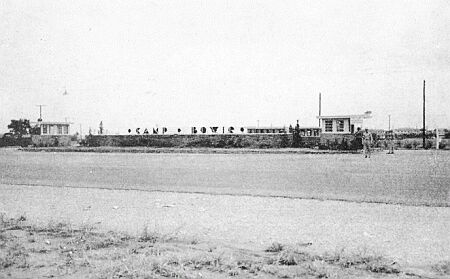

| Camp Bowie, located in Central Texas, was a military training
center during World War II. The campsite vas one and one half miles
south and east of the city limits of Brownwood, Texas. During the years
of 1940-1946, it grew to be one of the largest training centers of the
state. Approximately a quarter of a million men were processed here.
In 1940, the war situation in Europe caused the U. S. Congress to determine that it was time to strengthen the defense system. Then President Franklin D. Roosevelt was given the power to mobilize the National Guard units. The 36th Division of the Texas National Guard units arrived at Camp Bowie in mid December for their year's training. Before the year of training ended, war had been declared. On September 19, 1940, the War Department announced that a camp should be built at Brownwood. Work began at the camp on September 27, 1940. The Camp vas the first major defense project in the state and there was no scarcity of labor when the building work began. At one time more than 15,000 area men were employed on the project. On October 1, 1942, the War Department became the owner of 123,000 acres of land in Brown and Mills Counties. Before the War ended the campsite encompassed 5,000 acres and approximately 118,000 acres were used as training grounds. The urgent need to start training troops, caused the expansion of the pyramidal tents to be built. This lasted for about a year and a half, until more permanent buildings were built. At one time there were 6,072 pyramidal and 910 Wall tents at Bowie. Each tent housed five enlisted men. While living quarters were being built, larger buildings were going up all over the campsite. On March 1, 1941, it was reported that 213 mess halls and 224 bathhouses had been built. The men enjoyed sports and entertainment at the 22 recreation centers. There ass a large post exchange, with 27 branches, three libraries, one golf course. Three dental clinics and two Red Cross buildings. The hospital could take care of 2,000 patients, and the post had fourteen chapels. Atop the highest and most Olympian hill in Camp Bowie was the post Headquarters. Krueger Hill was the hub of the Camp's activities. General Walter Krueger, formerly the commander of the VIII Corps, was stationed on the hill. The hill was named for the man who led the Sixth Army in the Pacific. The original plan was a temporary training camp for the 36th Texas National
Guard Division. When war was declared the plans changed. Many of the men
stationed at Camp Bowie were from Brown and the adjacent counties. The
36th departed for Camp Blanding, Florida on February 15, 1942. Soldiers
of the Texas Division splashed ashore on the beaches of Salerno on September
9, 1943 to become the first allied soldiers to crack Hitler's Europe fortress
from the west. After 400 days of combat, five campaigns in Italy,
France, Germany, and Austria, the men of the Texas Division could be proud
of their
In December 1945, the men of the 36th came home as a unit to be discharged, The Division demobilized on Christmas Day, 1945. The first Women's Army Corps arrived at Camp Bowie November 16, 1943 to take over jobs and to free the men for overseas duties. There were two prisons in Bowie. The Rehabilitation Center that restored men back to duty and the German Prisoner of War Camp. The Rehabilitation Center was opened on December 1, 1942. From that date until 1946 there were 2,294 men restored back to duty. Only 12 percent could not be restored. The first German Prisoners of War arrived at Bowie in August 1943. Most of the men were members of Field Marshall Erwin Rommell's once proud Afrika Corps. When they got settled at Camp Bowie the 2700 men were well behaved. They worked at jobs on the Camp and became day laborers for the farmers and ranches in Central Texas. They raised their own vegetables and had their own burial grounds near the Jordan Springs Cemetery. On October 1, 1946, the U. S. Flag came down for the last time. On August 1, 1946, the War Department notified Texas members of Congress that the camp had been declared "surplus." The Civilian War Assets Administration was to take charge and began the distribution of the land and buildings, Today, 2002, there are few things at the campsite to remind us of the Camp Bowie Days. The campsite has become a medical center, complete with a hospital and other medical buildings. The site has become a place where people can gather to enjoy entertainments at the parks, the municipal pool, and the football and baseball sports complex. There are now homes, manufacturing plants and business in the area that was once called Camp Bowie. To read about exploring the burned rock middens found at Camp Bowie go to:
Return to Historical Web Sites Return to Historical Society Web Site |